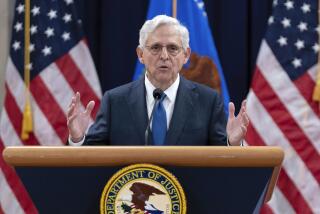Big U.S. banks keeping door open to another financial crisis
- Share via
There are two ways to think about how far we’ve come in protecting against a repeat of the financial meltdown five years ago that plunged the world into recession.
You can conclude that we’ve pretty much eradicated the risk of another such crisis. That’s the bankers’ viewpoint. Here’s how Morgan Stanley Chief Executive James Gorman put it in an interview with Charlie Rose earlier this month: “The probability of it happening again in our lifetime is as close to zero as I could imagine.”
Or you can conclude that we’ve done almost nothing to stave off another banking meltdown. That’s the realist’s viewpoint.
Financial historians may date the onset of the financial crisis from the collapse of Lehman Bros., which failed five years ago, on Sept. 15, 2008, though it was building for at least a year, and arguably several years, before that. Lehman’s fall may be perceived more accurately as a symptom, rather than the cause, of a disease that had already infected the financial system.
The virus hasn’t been cured, and while the patient itself — that is, the banking industry — seems to be back on its feet, it’s still a carrier.
Today’s big banks are materially larger than they were before the crash of 2008 — America’s six biggest banks have 28% more in assets than they did in 2007, according to an analysis by Bloomberg. The U.S. economy has been growing consistently, but slowly, since hitting bottom in 2009. Gross domestic product still remains 9% below where it would have been if the pre-2008 trend line had continued, and some analysts worry that the economy may have sustained “permanent damage” from the severe downturn.
Family incomes also have recovered, but the joy has been spread unevenly. As Berkeley economist Emmanuel Saez discovered in the latest of his invaluable updates on income trends in the U.S., the top 1% captured 95% of all income gains from 2009 to 2012 — the real family income among the top 1% grew by 31.4% in that period while everyone else gained only 0.4%.
Could it happen again? You bet it can, says Anat Admati, a professor of finance and economics at Stanford and co-author of “The Bankers’ New Clothes,” a book published in February that details the shortcomings of banking regulation today. That’s because big banks are still too deeply hooked on borrowing and on making deals in shadow markets that are almost impossible for regulators to track.
“Fundamentally not that much has changed,” she says. “There’s still a lot of risk in the opaque markets that we don’t see, still a lot of leverage that we only discover when it’s too late.”
Most disturbingly, the banks that played so central a role in the crisis have fought to a draw the implementation of new rules under the 2010 Dodd-Frank Wall Street Reform and Consumer Protection Act.
That’s a big difference from what happened in the 1930s, after a huge market crash helped bring on the Great Depression. By 1934, we had federal deposit insurance, the remaking of rules and regulations for the stock exchange, the creation of the Securities and Exchange Commission, and disclosure rules that brought unprecedented transparency to corporate financial reporting.
Sure, Wall Street and the banks kicked at the changes, claiming they would interfere with economic growth. But they didn’t get their way.
They’re getting their way now. They’ve watered down regulations aimed at keeping them from fobbing bad loans off on investors by requiring that they hold larger portions of the loans on their own books. They’ve made sure that rules requiring transparent, exchange-based trading of derivatives — those intricate financial contracts that magnified what could have been manageable losses into a global financial catastrophe — are shot through with loopholes.
Consider the fate of the Volcker Rule, a provision of Dodd-Frank aimed at preventing banks from making risky trades for their own accounts (though not on behalf of customers). The banking industry kept up a full-court press against the Volcker Rule, which was named after its creator, former Fed Chairman Paul Volcker, virtually from the moment of Dodd-Frank’s passage.
As Duke University law professor Kimberly Krawiec has documented, between July 2010 and October 2011 the nation’s top banks, their law firms and their lobbying groups got 419 meetings with federal regulators to dicker over the rule. In the same period, public advocacy groups such as the AFL-CIO and Public Citizen got 19 meetings. Paul Volcker himself got only one. Are you shocked to learn that the rule has been so laden with exemptions that it’s unlikely to achieve anything?
And the jawboning continues. This year alone, representatives of Barclays Bank had two meetings with Federal Reserve governors and staff members. In one of these meetings, there were 10 Barclays officials in the room, versus four outgunned Fed staffers.
You may have heard the name Barclays before. That’s the British-based bank that last year paid a $450-million fine for manipulating the Libor, a key interest rate for borrowers. The bank also faces a $453-million federal fine for rigging the California electricity market, though it says it’s innocent and vowed to take the case to court.
And yet it seems to have no trouble getting in the door of the Fed. How would you feel if your local D.A. took meetings with convicted felons to get their thoughts on how our tough criminal laws should be eased up? That’s not far from what the Fed and Barclays are up to.
But that’s only one facet of bankers’ seeming immunity from prosecution for the wrongdoing, including fraud, that led to the crash.
No high-level executive of any major bank has faced trial. Most have escaped with much of their wealth intact. No top executive of Bank of America, Bear Stearns, Lehman Bros., Goldman Sachs, Wells Fargo or JPMorgan has even been sued personally by the Securities and Exchange Commission.
The SEC recently launched a valiant defense of its performance in the crisis, pointing out that it has charged 66 CEOs and other “senior corporate officers” in connection with the crisis. But none was at Lehman or any of the other major banks. SEC officials say they simply couldn’t make the case that Lehman’s failure resulted from fraud.
Is that so? Lehman’s federally appointed bankruptcy examiner, Anton Valukas, said he found “actionable balance-sheet manipulation” at Lehman and significant nondisclosures of accounting tricks designed to conceal its true condition.
In the words of William K. Black, who oversaw the prosecution of bankers after the savings and loan crisis of the 1980s, the SEC’s own figures “demonstrate its epic failure in preventing the current crisis (the SEC was useless) and deterring future crises (the SEC leaves the fraudulent wealthy officers immensely wealthy).”
There’s more to suing or prosecuting these executives than merely satisfying the public’s passion for retribution. There’s also the need to discourage a return to the old ways.
That message hasn’t been heard by the banking industry. Although executives say the banks have much stronger capital cushions today than they did before 2008, Admati contends they aren’t nearly strong enough.
The average reported ratio of equity to assets among the big banks — equity being the safest capital one can have — is about 10% to 11%. Admati says it should be closer to 30%, so that the banks would be able to survive a market crash like the one that put Lehman, Merrill Lynch, Bear Stearns and other onetime gilt-edged names out of business.
She also points out that the lax rules about what risky investments must get reported as balance sheet assets and what can be left off undermine confidence in the banks’ figures. “Their fragility is hard to see from their balance sheets.”
The banks today still fight regulation by claiming that tying their hands will hobble economic growth. This is one of those balancing tests where all the weights seem to have been piled on one side. What’s left off is the cost of inaction.
Earlier this summer, economists at the Federal Reserve Bank of Dallas took a crack at measuring that cost. Their conclusion was that the Great Recession cost the U.S. as much as $14 trillion in economic output, or up to $120,000 for every household in the country. That comes to a lot more than the cost of keeping a few bankers from collecting their bonuses through risky, manipulative financial deals.
The targets of regulation always squeal that trampling on their freedom of action will have economic costs. But the reality is that the cost of lax regulation is always higher than the cost of making a system safe. The U.S. understood that reality in the Thirties. What keeps us from understanding it now?
Michael Hiltzik’s column appears Sundays and Wednesdays. Reach him at [email protected], read past columns at latimes.com/hiltzik, check out facebook.com/hiltzik and follow @hiltzikm on Twitter.
More to Read
Inside the business of entertainment
The Wide Shot brings you news, analysis and insights on everything from streaming wars to production — and what it all means for the future.
You may occasionally receive promotional content from the Los Angeles Times.











